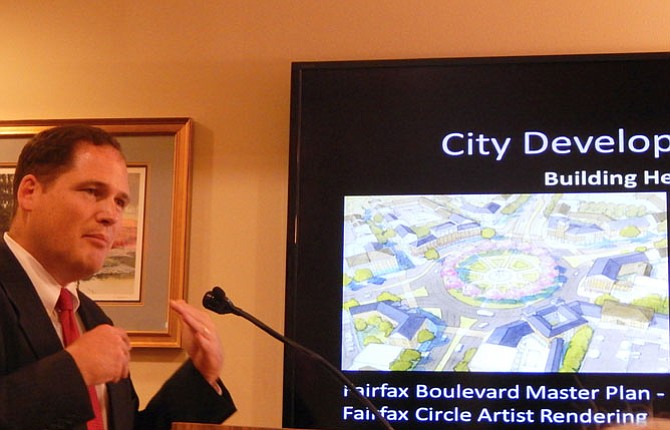Brooke Hardin, the City’s director of Community Development and Planning, discusses the Fairfax Boulevard Master Plan during an earlier work session. Photo by Bonnie Hobbs.
In April 2012, the City of Fairfax adopted the Master Plan vision for the redevelopment of Fairfax Boulevard. It transformed this 3.5-mile corridor from transportation-oriented to more pedestrian friendly.
The plan supports office, retail and residential uses together, with storefronts at ground level, living spaces or offices above, parking in the rear and vehicle access via side streets and alleys. And in Nov. 2014, the City Council asked the Planning Commission to review the plan and recommend whether some or all of it should be incorporated into the City’s Comprehensive Plan.
“The Comprehensive Plan was created in 1988 and updated and amended,” said Brooke Hardin, the City’s director of Community Development and Planning. “But we’d support taking a fresh look at it and rewriting the whole thing.”
Fairfax Boulevard includes the Kamp Washington Center, East and West Connectors, the Northfax Center and the Fairfax Circle Center. And from January to June of this year, the Planning Commission reviewed the Fairfax Boulevard Master Plan. Then during a July 7 joint work session of the commissioners and Council, City Planning Division Chief Cindy Petkac gave a presentation describing what’s in the Master Plan and how it relates to what’s in the Comprehensive plan regarding that corridor.
THE MASTER PLAN describes buildings as two to four stories. It also recommends a multi-way boulevard with five, narrowed travel lanes in the middle for heavy through traffic. Also included are landscaped medians plus one-way, access roads – called slow lanes – with on-street parking.
The Comprehensive Plan for Fairfax Boulevard recommends landscaped medians, as well, and enhanced streetscape features and smaller blocks to encourage pedestrian activity. It, too, mentions slow lanes, but doesn’t provided any details. And it supports a mix of uses and a balance of traffic with the safety and character of the corridor.
After its review, the Planning Commission made more than 80 comments dealing mainly with zoning, data and policy issues. “The bulk of the comments were policy-related – about things such as building height, density [of development], right-of-way, etc.,” said Petkac.
There was concern that the business community wouldn’t want to provide the land required for the 156-foot right-of-way needed for the slow lanes. And the commissioners wanted to know where the access points would be for the one-way, local roads and how many such access points there’d be. In addition, since the nearby signalized intersections back up, they wondered how efficient traffic circles are when backed-up traffic goes through them.
“The Master Plan wasn’t a finished document,” said Planning Commission Chairman Paul Cunningham. “Some issues still beg clarification.”
ACCORDING to the Planning Commission, the current Comprehensive Plan implements the main ideas in the Fairfax Boulevard Master Plan. But changing economic conditions and ambiguity around several matters still need to be addressed and concepts further refined. So the commissioners recommended these issues be dealt with in an update of the Comprehensive Plan, as follows:
*Determine the appropriate building heights, density and mix of uses, reflective of current market conditions, planned projects and a Commercial Development Market Analysis earlier prepared for Fairfax Boulevard by the firms Streetsense and Partners for Economic Solutions.
*Further investigate the multi-way boulevard concept, as well as slow lanes, roundabouts (traffic circles), bike lanes, traffic-signal timing, reverse lanes, municipal parking and walkability as part of the multimodal transportation plan.
*Reestablish the vision for Fairfax Boulevard – develop a single, guiding set of principles for how to maximize, to the fullest extent possible, the economic viability and livability of this corridor.
“These issues could be defined in the Comprehensive Plan update,” said Petkac. “And we’ll also do a multimodal transportation plan in relation to the City and the I-66 corridor.”
When shown information about the current traffic volume on various sections of Fairfax Boulevard, Mayor Scott Silverthorne said, “I find it interesting that our traffic counts are [virtually] the same as 10 years ago. [That road] certainly doesn’t move as fast as it did then.”
Councilman David Meyer then encouraged City staff to “see if the traffic on Fairfax Boulevard is coming to town or driving through it.”
